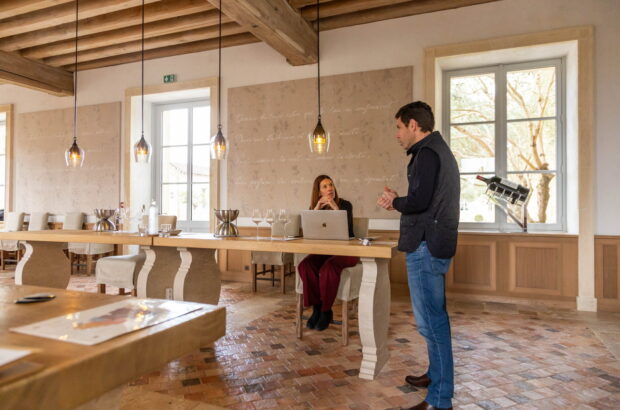Jarrett Michael Buffington (@dr.buffington) is an American-born sommelier currently residing in Australia, and participating in wine immersion experiences around the world. Keen to broaden his horizons, Jarrett gained sommelier experience in Seattle, Napa Valley, New Zealand, Adelaide and Tasmania before settling in Sydney. As a recipient of the 2022 Taylor’s Port Golden Vines Diversity Scholarship through the Gérard Basset Foundation, Jarrett will undertake the Master Sommelier exam for the first time in London, October 2023.
We live in the best time in the world to drink wines from all over the globe. I’ve always been inspired by the wines less known, with a tendency to shun the mainstream and cheer for the underdog. Which has often led me to wine regions that many would think of as unconventional. Saperavi has interested me since I first read about the wines of Georgia. This recently materialised into a journey to the Republic of Georgia hosted by Shalva Khetsuriani, owner of Khetsuriani Winery, president of the Georgian Sommelier Association, and a man who played an integral part in the creation of the Riedel varietal-specific Saperavi glass. Georgia is a country with a rich cultural history, still somewhat finding its feet in the modern world after the collapse of the Soviet Union in the early 1990s.
Often referred to as the ‘cradle of wine’, because there is proof of winemaking tradition in Georgia dating back to 6,000 BC, the country’s history and aptitude in winemaking made the Republic of Georgia the ideal source of large quantities of wine production in service to the Soviet Union. Georgian wine is still very niche, if maybe not as unfamiliar in name today, but I would dare say that most wine drinkers have not partaken in a glass.
Unsung hero
When referring to Georgian wine it is not uncommon to think about ‘orange wine’, skin-contact white wines vinified and aged in clay amphorae of various sizes known as qvevri. This ancient, yet now very fashionable style has in recent years been emulated in winemaking regions around the world.
In my opinion, the unsung hero of Georgian wine is the native grape Saperavi, a black-skinned teinturier variety (with dark flesh, too) that has the capacity to adapt stylistically to oak and/or amphorae, making dry, ageworthy red wines with plush red and black fruits and savoury undertones. During Georgia’s time as part of the Soviet Union, uncomplicated but surprisingly delicious semi- sweet reds made from Saperavi were common, and they are still popular today.
In the glass
Deciphering an inky and opaque glass of Saperavi isn’t always easy. What I’ve found is that oak-aged Saperavi can have plush notes of black and blue plums, cedar, spice and a tinge of green, not dissimilar to Pomerol. Also, Saperavi vinified in qvevri are often made to a minimal-intervention philosophy and, along with pristine red cherry and blackcurrant fruits, can exhibit heady, dark floral aromas that travel intensely to your olfactory senses. As mentioned previously, there are the semi-sweet styles of Saperavi that would be scoffed at by most people, but the high polyphenolic background of Saperavi keeps these wines quite in balance.
Food matching
Georgia is a proud gastronomic country with a growing number of sommeliers. You’ll find no shortage of wine bars or restaurants serving local cuisine. Georgia is not a flashy country – my experience is that Georgians don’t want to show off a new car, or fancy jewellery; instead they want to show off their culture, cuisine and most of all their legendary hospitality.
Saperavi pairs extremely well with traditional Georgian dishes khinkali (stuffed dumplings), khachapuri (pizza-like cheese and egg dish) and kebabi (lamb kebabs). It’s a versatile grape, and at home I’d pair the lighter, more minimal-intervention styles with a simple spaghetti bolognese and the more robust, oak-driven styles with braised beef ribs and creamy polenta.
Discover Saperavi: Jarrett’s three to try
Most Saperavis from Georgia don’t travel far and I am always an advocate of tasting at the source when feasible. But that doesn’t mean there aren’t great examples being exported. Pheasant’s Tears, Saperavi 2021 from Kakheti region (£22 The Good Wine Shop) is a collaboration that began in 2007 between Georgian wine-grower Gela Patalishvili and American John Wurdeman. Their Saperavi is naturally fermented in qvevri buried in the earth – they make their wine in the most traditional sense, giving an expression of black and red fruit, rusticity and elevated acidity.

To discover a more modern expression, try Shumi’s Saperavi 2020, also from Kakheti (£14.50 Taste of Georgia). Shumi is a highly awarded and picturesque winery situated in the heart of the village of Tsinandali. This bottling has a ready-to-drink, contemporary flavour profile with supple black berry and cherry flavours and an approachable tannin structure.

One more to seek out is the Saperavi 2017 from Lukasi (£38 Taste of Georgia), a boutique winery in Kakheti. The wine spends 12 months in oak barrels, lending a classical feeling to an ancient variety. Enjoy brooding dark fruits and a velvety texture, with potential to soften and exude more layers over time.













